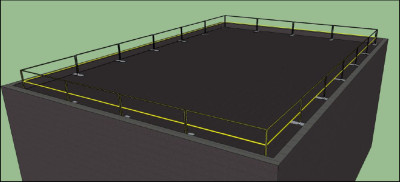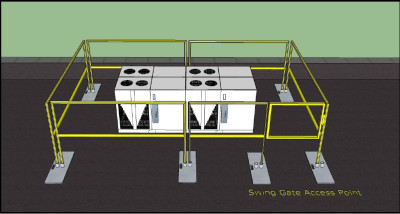Rooftop Safety Railing Perimeter Planning Guide
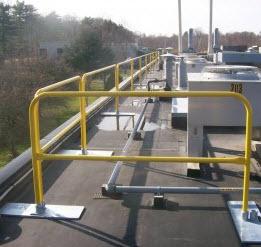 Freestanding safety railing is one of the simplest forms of rooftop fall protection. Unlike horizontal lifelines or single point anchors, which require worker tie-off, a rooftop guardrail system requires very little of its user. Employees don’t need to wear a harness, connect to an anchor point, or receive training in the safe use of the system. That said, you’ll need to do some planning prior to installing freestanding rooftop safety railing systems to ensure worker safety and OSHA compliance. This post serves as a guide to determining baseplate and railing section requirements when installing our LORGUARD safety railing.
Freestanding safety railing is one of the simplest forms of rooftop fall protection. Unlike horizontal lifelines or single point anchors, which require worker tie-off, a rooftop guardrail system requires very little of its user. Employees don’t need to wear a harness, connect to an anchor point, or receive training in the safe use of the system. That said, you’ll need to do some planning prior to installing freestanding rooftop safety railing systems to ensure worker safety and OSHA compliance. This post serves as a guide to determining baseplate and railing section requirements when installing our LORGUARD safety railing.
The Importance of Baseplates
When planning a free-standing safety railing installation, remember to start from the ground up. Although many folks think the railing sections are the most important part of free-standing guardrail systems, baseplates are important too. Each section of guardrail fits into a baseplate that rests on the roof’s surface, so it is important to have an accurate count of baseplates required to complete the install. You may assume that the baseplate count equals the number of required railing sections, but this is not always the case. To properly calculate baseplates requirements, you’ll need to determine if your railing system is an open or closed layout.
Open Versus Closed Layouts
Complete enclosures with no means of access are considered closed systems. Typical closed-system applications include skylights enclosures and full perimeter rooftop guarding. If your layout requires a gate or leaving a side open for access, your layout is considered open. Open guardrail systems are common around HVAC units, condensers, and other rooftop equipment that requires periodic maintenance.
How Does Layout Determine Baseplate Requirements?
Each baseplate has two rail receivers. If you have a closed layout, your last rail leg is inserted into the second receiver of your first base plate. So for any closed system you need one base plate for every piece of rail you order.
Example: A 5’ x 5’ skylight requiring complete enclosure requires 4 (four) 6’ rails and 4 baseplates as shown below:
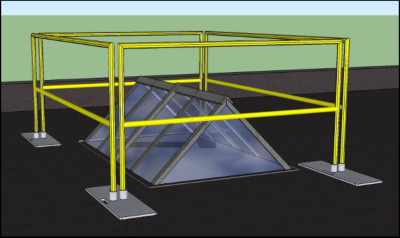 Closed System Around Skylight Screen – 1:1 Rail to Baseplate Ratio
Closed System Around Skylight Screen – 1:1 Rail to Baseplate Ratio
Full Perimeter Closed Layout
If you have an open layout, the last leg of your last rail will not go into your first base plate.
Important Note: If your railing system requires an open leg of rail or a swing gate, you’ll require one extra base plate to finish you project.
Example: A 15’ x 8’ HVAC unit requires four 10’ rails to surround the equipment on three sides with one side open for maintenance access. This scenario requires FIVE base plates so the last rail leg has a baseplate, as shown in the illustrations below:
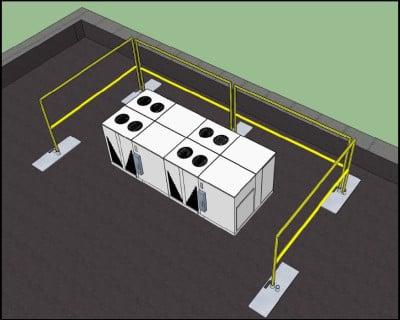 Typical Open System – Rooftop HVAC Unit Near Leading Edge Requires Four Railing Sections and Five Baseplates
Typical Open System – Rooftop HVAC Unit Near Leading Edge Requires Four Railing Sections and Five Baseplates
Although the system looks like a closed system, the swing gate gives access, making it an open system that requires one extra baseplate.
Calculating Your Safety Railing Needs
To calculate your safety railing needs, start by taking some simple measurements. For closed systems, a perimeter measurement will suffice. For an open system where access is required, measure the size of the intended coverage area and add an additional 36” so maintenance personnel have plenty of space to work. For example, on a 6’ x 6’ HVAC unit, provide 12’ of rail on the leading edge side so your worker has three feet of space on either side of the unit to perform their work.
A Word on Outriggers and OSHA Compliance
OSHA’s guardrail regulations require that safety railing systems can withstand 200 pounds of force in any direction on the top rail and 150 pounds in any direction on the mid rail. Since the LORGUARD system is a free standing, the outriggers are required to comply with OSHA force regulations.
What’s Holding You Back?
As this post demonstrates, calculating your baseplate and railing section requirements prior to installing a freestanding safety railing system is a relatively simple process—and installation is easy too. If you are ready to get started on a rooftop safety railing system, visit our ecommerce site at www.SafeProSafety.com or feel free to email or give us a call for further assistance.
Schedule an assessment with Diversified Fall Protection
Contact Us to request a fall safety review

b-1.jpg?width=1368&height=1340&name=Rail%20(175)b-1.jpg)


